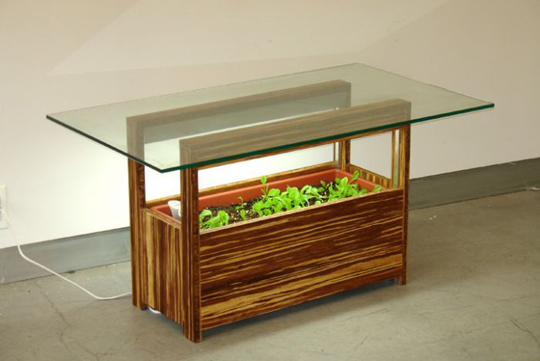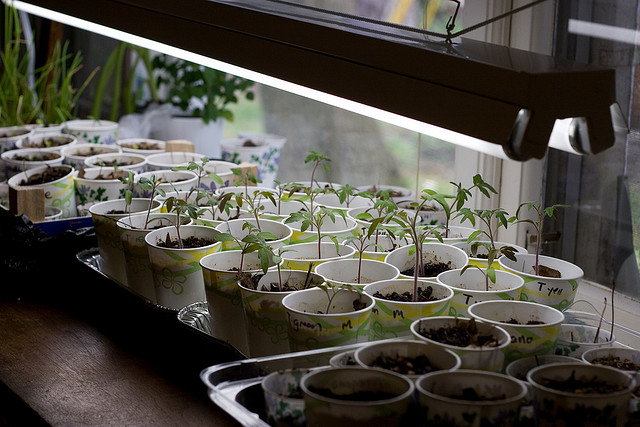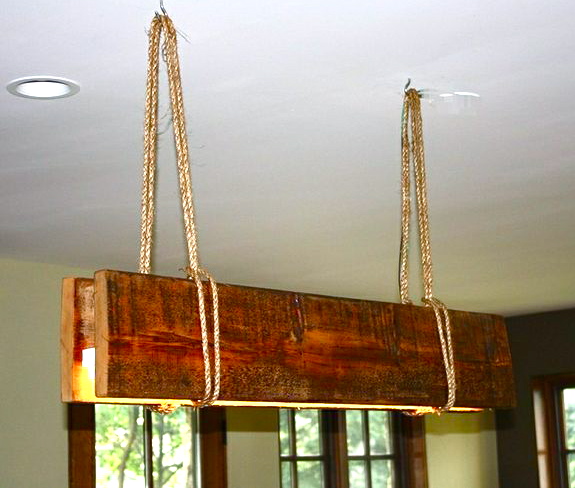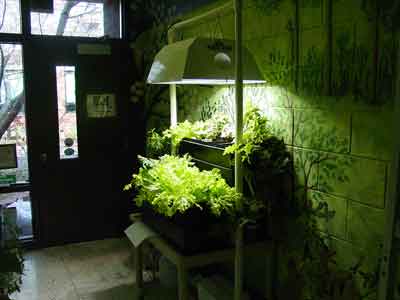(image)
When I hear the words “grow lights” I immediately think of drug dens. And I’ll tell you something that I’m pretty sure is 100% true. People who grow marijuana in their closets aren’t doing it because they think the cannabis or the requisite grow lights are aesthetically pleasing. I, on the other hand, care quite a bit about the look of my indoor herb garden (by which I mean basil or rosemary or whatever. And “whatever” is not code for weed). The general hideousness of most grow light setups has been enough to keep me away from them to date. But as is evidenced by that rather attractive coffee table above, there’s nothing that says grow lights have to be ugly. So let’s talk.
Here’s the trouble with winter: although your home is hopefully heated to a temperature that will sustain plant life, even on the sunniest of window sills, this time of year there’s just not enough light to keep herbs or fruits or vegetables alive and thriving. What about your regular lightbulbs? Can’t plants get the extra light they need from those? The answer is that regular incandescent bulbs help, but they don’t have light in certain ranges of the UV spectrum that turn out to be rather critical for photosynthesis. That’s where grow lights come in.
There are a whole bunch of different kinds of light bulbs that can all technically be called grow lights. I’m going to eliminate most of them from the discussion because they’re scary looking. Don’t believe me? Here’s a little look.
High pressure sodium grow lights emit a sort of orange-red glow that’s Halloween eerie (that’s them in the middle). LED grow lights are red or blue and intergalactic scary (that’s them on the edges). Incandescent “grow lights” are generally too weak to do much good, so they’re out as well. The most straightforward and also least ugly of the potential grow lights out there, in my humble opinion, are your basic fluorescent light tubes.
(image)
See how unscary those are? In an ideal setup you have two fluorescent tubes, one “cool light” fluorescent tube, one “warm” or “daylight” fluorescent tube. Alternatively, you can go for a single “full spectrum” fluorescent bulb, which covers both ends of the spectrum.
Even the least ugly of the grow lights can still be ugly, though. So I’ve scoured the internet for the prettiest setups to inspire you and me both. There’s that coffee table up there. Cool, right? Then there’s this hanging reclaimed wood lamp. I find it quite appealing:
So rustic industrial. You can order it here.
Last, but not least, is a more straightforward option:
(image)
I think that’s PVC pipe holding the lamp. The profusion of plants helps, and notice that mural on the wall behind the light? It makes the whole thing so fanciful and bold. Like, “No I’m not trying to blend in. I’m a huge grow light shelf. Deal with it.” I think that makes it awesome.
So maybe this is my grow light year. Anyone else want to join me on the adventure? Let’s chat.
Tags: grow lights, winter gardening




Loving the mural!
Our set-up is by no means the most aesthetically pleasing in the world, but it helped us prepare 72 tomato seedlings, 48 peppers, and countless other vegetables last year (and in the back bedroom, I’m really the only one who regularly notices it). I included some photos in this morning’s post: http://gardeninggrl.wordpress.com/2012/01/16/garden-planning-plotting-things-out/ We used a recycled florescent light fixture with 4 – T8 “daylight” bulbs, running it 12 hours/day on a timer.
My husband and I were just talking about this last night! We have no room except in the basement and it is too cold down there and I am afraid I’m too lazy to set up some elaborate heating/light scenario… Although I suspect it doesn’t have to be that difficult.
Just discovered this site and am feeling a little inspired.
Hi Mindy,
Agreed — I think it can be easier than you’d think. You’ll have to let us know if you do it!
I have started my garden inside and early, for five years now. Heating pads and T-5 flouresent lights are the tools I use. Works great and starting early from seed lets me really space out my crops and ensure I have a continuous harvest. Great blog!
Thanks! Glad you found us! I’m looking forward to getting an early start this year as well.
Can my basil survive the winter if I use grow lights? My basil kind of survived without them but now seems to have developed some sort of invasion of aphids or whitefly (are these the same?). Some online sources have suggested that I bring my basil plant to a ladybug farm because ladybugs will eat the critters eating my basil, but I don’t know where to find wild ladybugs in my neck of Gowanus.
I have graduated from summer garden, to winter protected gardening to winter indoor gardening. I have purchased a 6 foot tall chrome shelving unit and attached our current floresent light…. I have plans to pick a second one up for the second shelf. So, I now have a small black self watering grow centre for starting seedlings, a second shelf for spring start up, and a winter garden shelf. That shelf contains Thai basil, sweet basil, lettuce, spinach and my two summer eggplants that are not yet ripe. As they are easy to self pollinate, I am going to see how long I can grow them over the winter. I may attempt a cucumber ! Who knows what I can grow ? Either way, I am well on my way to lowering my grocery bill and eating more organic!